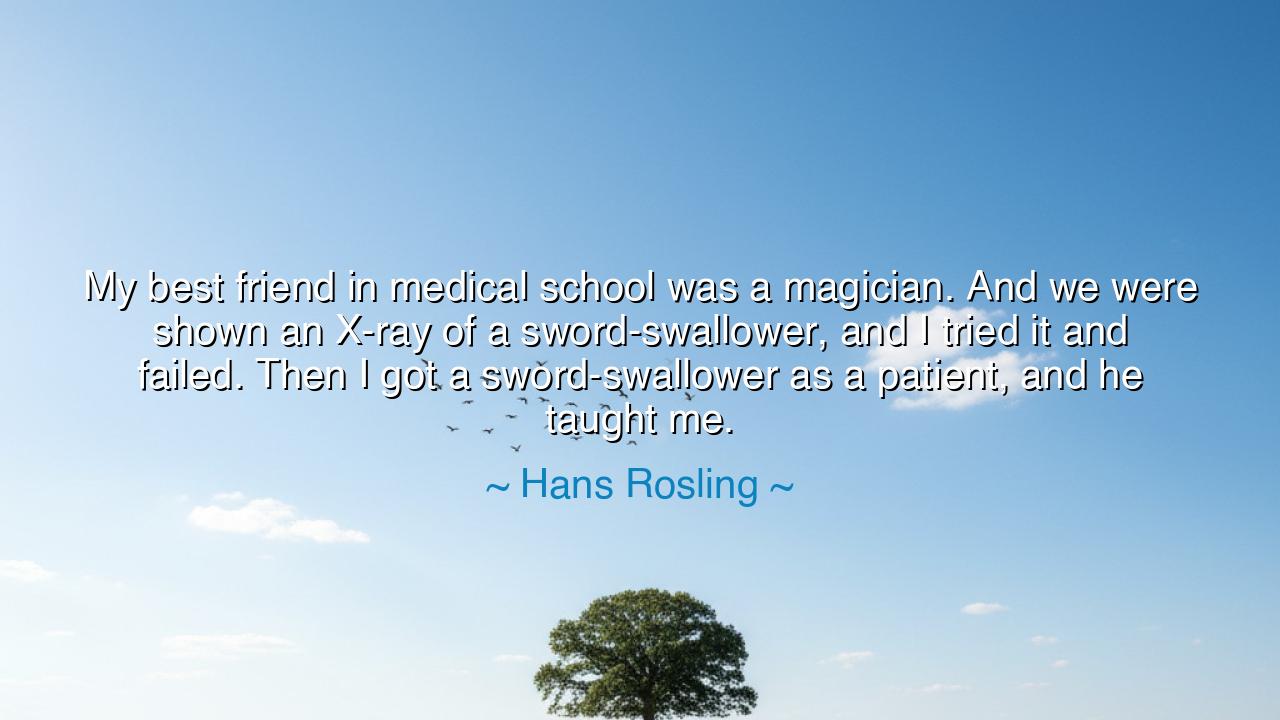
My best friend in medical school was a magician. And we were
My best friend in medical school was a magician. And we were shown an X-ray of a sword-swallower, and I tried it and failed. Then I got a sword-swallower as a patient, and he taught me.






“My best friend in medical school was a magician. And we were shown an X-ray of a sword-swallower, and I tried it and failed. Then I got a sword-swallower as a patient, and he taught me.” Thus spoke Hans Rosling, the great physician, teacher, and truth-teller of data — a man who sought to unite science and wonder, logic and curiosity. His words, half in jest, conceal a profound lesson about humility, learning, and the courage to fail. In this short story, wrapped in humor and human warmth, Rosling reveals the eternal truth that wisdom is born not only of study, but of experience; not only of success, but of failure; not only of knowing, but of learning from others — even from those whom the world might overlook.
The tale begins with playfulness: a young medical student, eager to learn, seeing the mystery of a sword-swallower’s X-ray — a blade inside a living body, defying fear and anatomy alike. In that moment, Rosling, driven by the same curiosity that fuels all discovery, attempted to imitate it. He failed, of course, but failure did not shame him — it awakened him. For in that failure was the beginning of understanding. The sword-swallower was not reckless; he was a master of discipline, patience, and self-knowledge. What medicine could not teach through charts and diagrams, life itself revealed through encounter. When Rosling later treated such a performer as a patient, he did not remain the superior doctor instructing the lesser man; he became a student once more, humbly learning from the very one he was meant to heal.
This story, small and strange though it may seem, shines with the light of true wisdom: that the path to mastery requires curiosity unchained by pride. In ancient times, the philosopher Socrates declared that the wise man knows he knows nothing. Rosling, in his own century, echoed that same truth through humor and humility. Though trained in the highest halls of medicine, he bowed before the experience of the performer, learning not from textbooks but from the living body and the human spirit. In that moment, the healer became the disciple, and the world itself — with all its mysteries and absurdities — became his teacher.
There is another layer to this tale: it speaks of the marriage of science and wonder, a union too often divided by arrogance or fear. The magician and the doctor — symbols of illusion and truth, of showmanship and precision — are here united in friendship. Rosling’s best friend in medical school was one who dealt in wonder, reminding him that even in science, the sense of amazement must never die. When the X-ray of the sword-swallower appeared, it was not merely an image of anatomy; it was a revelation of human daring, of how far the body — and the will — can go when guided by courage and understanding. Rosling’s life, devoted to revealing truth through data, was built upon this same foundation: that facts are wondrous, that learning is an act of awe.
From this story, we may draw a lesson as old as time: do not let your learning make you proud; let it make you curious. The scholar who refuses to learn from the ordinary man is already lost in ignorance. The healer who stops listening to his patient ceases to heal. The leader who ceases to ask questions begins to decay. Rosling’s respect for the sword-swallower was not mockery; it was reverence — a recognition that every human being carries knowledge that no book can contain. True mastery is not the possession of knowledge, but the willingness to keep learning from every encounter.
Consider, too, the humility of the great Leonardo da Vinci, who dissected corpses not for fame but for understanding, and who saw art and anatomy as twin paths to truth. He observed, he questioned, he failed, and tried again — until the mystery of the human body unfolded before him. Like Rosling, Leonardo knew that to learn is to wonder, to blend the discipline of science with the playfulness of discovery. For both men, curiosity was sacred, and every mistake a step toward enlightenment. The wise do not fear failure; they use it as a mirror to see more clearly.
So, my children, take this teaching to heart: be both scientist and magician in your own life. Seek knowledge with rigor, but never lose your sense of amazement. When you fail, do not despair — for failure is a teacher more honest than success. When you meet another, no matter their station, listen — for even the humblest soul may hold the key to your next revelation. And when life offers you the strange and the wondrous — the sword-swallower, the magician, the unexplainable — approach it not with ridicule, but with respect. For as Hans Rosling’s story reminds us, learning is a sacred act, and wisdom blooms not in pride, but in the eternal dance between curiosity and humility.






AAdministratorAdministrator
Welcome, honored guests. Please leave a comment, we will respond soon